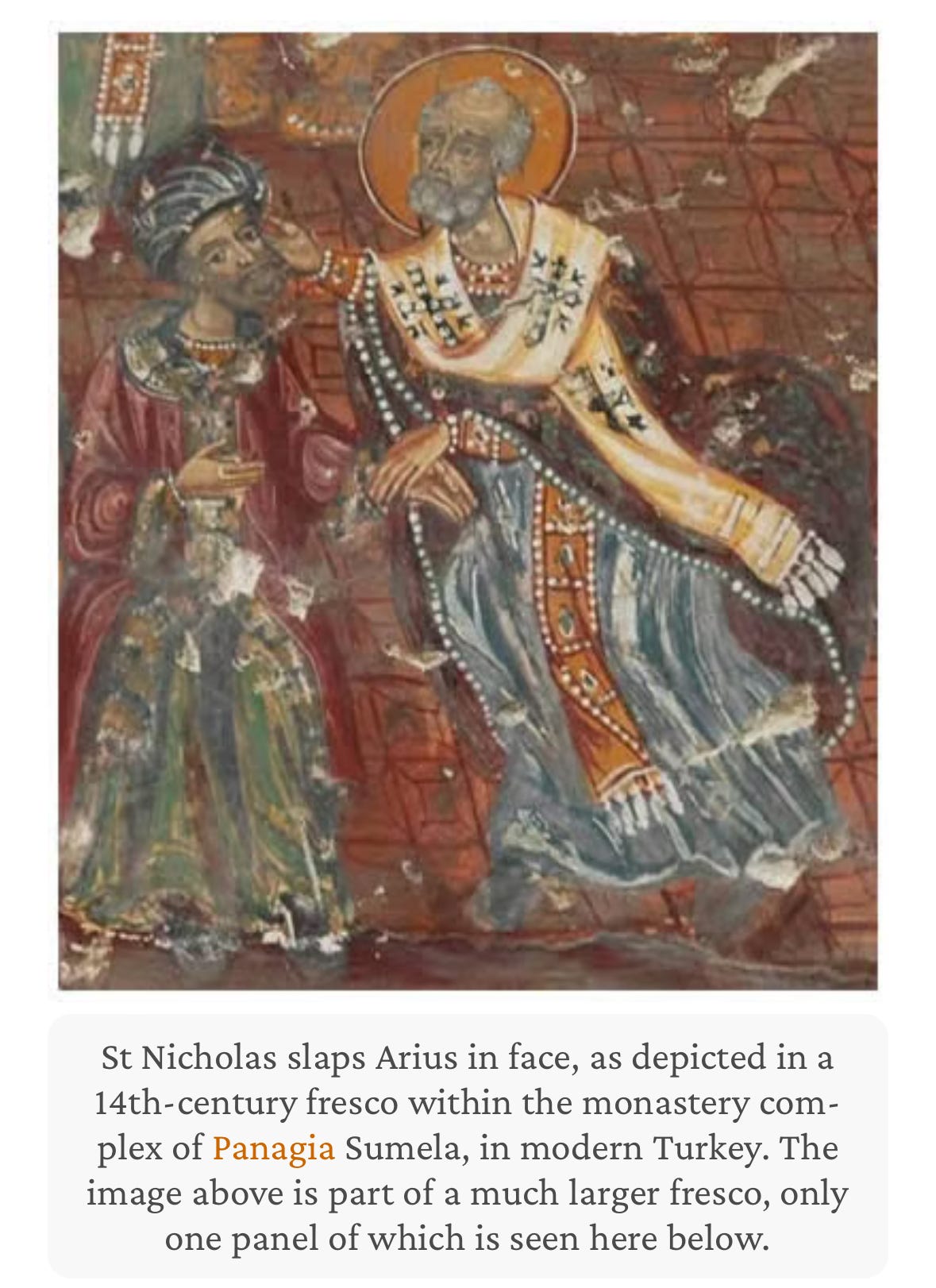St. Nicholas: The Fighting Bishop Who Became Santa Claus
By Catherine Salgado
Everyone knows who Santa Claus is. But centuries before he became the jolly sleigh-riding elf we all love, St. Nicholas was a bishop in Turkey who performed miracles, got into fisticuffs with a heretic, and, of course, gave out presents. And we can all continue to learn from and be inspired by this unique saint.
Today (Dec. 6) is [was] the feast of St. Nicholas, still a very important feast for Byzantine Catholics and Orthodox Christians. He was bishop of Myra in Turkey. He was born to rich, pious parents, although they died while he was still young. During the harsh persecutions of Roman Emperor Diocletian he confessed his Christian faith but, unlike so many other Christians of that era, survived (though he was put in jail). Nicholas was still quite well-off when he was free, but he chose to donate his wealth to the poor.
In one instance, Nicholas saved three poor girls from prostitution and/or slavery by throwing bags of gold in their window on three separate occasions, thus providing dowries so they could be married instead of enslaved. On the third night, when the father caught Nicholas at his secretive charity, the bag of gold Nicholas tossed in is said to have landed in a stocking drying before the fire. Yes, that’s the story that inspired the hanging of stockings which St. Nicholas still fills with presents today! Tradition also holds that the three golden balls hung outside a pawnbroker’s were based off this story.
Of course, not all of Nicholas’s help was monetary. He is said to have raised to life again children who had been murdered and pickled in a brine-tub. St. Nicholas was always there for the kids!
Beyond the multiple miracles Nicholas performed during his lifetime, including saving a ship caught in a storm by praying, we also have tales of Nicholas’s miracles after his death. That’s even before the old traditions in many countries including Poland, Russia, Ukraine, England, and Germany labeled him a Christmas-tide bringer of gifts. For instance, it is said that during one year’s celebration of Nicholas’s feast day in Myra, pirates attacked, snatching a young boy who was subsequently made the cupbearer of his captors’ ruler. On the next St. Nicholas day, the bishop appeared to the boy, blessed him, and miraculously brought him back home again to his parents! Just like with the story of the murdered boys above, it seems St. Nicholas has always been a special friend of children.
St. Nicholas Center cites “Byzantine tradition” as the story’s source, indicating either oral sources or written sources no longer extant. The story as handed down is that Nicholas lost his symbols of episcopal office, the pallium and mitre, over this incident. Apparently his fellow clerics didn’t approve of Nicholas’s way of dealing with heretics! But Jesus and Mary appeared in a vision and restored Nicholas’s lost symbols of office, and the holy bishop was vindicated. After all, Jesus cleansed the Temple with a whip.
So what does this story teach us? For one thing, that we have to be willing to do anything that is not sinful to defend truth. To some modern Christians, who have been told that love and mercy mean never so much as warning a sinner of the reality of Hell, it might sound odd that physical violence could be necessary to defend truth (though admittedly the circumstances for that are fairly narrow). Yet, as I noted above, we know that Jesus Himself, the same Who told us to turn the other cheek, used aggression when necessary to stop the profanation of the Temple.
“And he found in the temple them that sold oxen and sheep and doves, and the changers of money sitting. And when he had made, as it were, a scourge of little cords, he drove them all out of the temple, the sheep also and the oxen, and the money of the changers he poured out, and the tables he overthrew [Jn. 2:14-15].” Just like Jesus, just like St. Nicholas, just like our Founding Fathers, we have to understand that they are things and beliefs and people worth fighting for—the truth most of all.
In his homily today, my parish priest noted that St. Nicholas is a perfect saint for the season of Advent leading into Christmas, because he believed so strongly in the incarnation of God as man. Furthermore, he suffered and sacrificed for the truth even while going out of his way to bring joy and prosperity to others. While many now look around and see a world careening toward irretrievable disaster, they forget that disaster is only inevitable as long as good people are silent and passive. We might not be able to bring about world peace, but we can bring peace and justice to our own little part of the world.
Like St. Nicholas, let us zealously fight for and defend the truth, renew our faith, and bring joy to others in need this Advent and Christmas season.
****
Catherine Salgado is an accomplished writer and investigative reporter who publishes daily at her Substack column, Pro Deo et Libertate (For God and Liberty). This superb column provides news and opinion pieces from an honest, common sense perspective in the spheres of culture, politics, liberal arts, and religion. The Prickly Pear is grateful for her permission to reproduce her public writings and recommends that our readers subscribe to Catherine’s superb Substack column. Please consider a paid subscription for full access to all of her excellent and informative writings.
TAKE ACTION
As we move through 2023 and into the next election cycle, The Prickly Pear will resume Take Action recommendations and information.
This article is courtesy of ThePricklyPear.org, an online voice for citizen journalists to express the principles of limited government and personal liberty to the public, to policy makers, and to political activists. Please visit ThePricklyPear.org for more great content.


